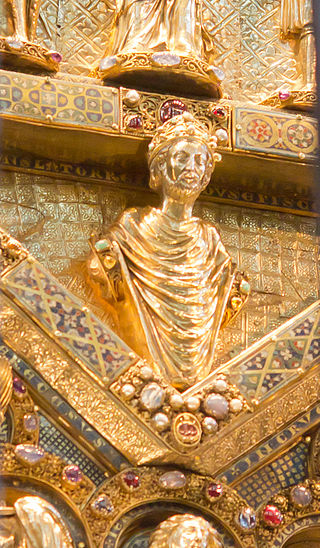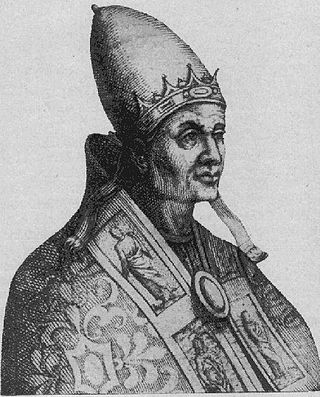
Year 1167 (MCLXVII) was a common year starting on Sunday of the Julian calendar.

The Battle of the Allia was fought c. 387 BC between the Senones – a Gallic tribe led by Brennus, who had invaded Northern Italy – and the Roman Republic.

Tusculum is a ruined Roman city in the Alban Hills, in the Latium region of Italy. Tusculum was most famous in Roman times for the many great and luxurious patrician country villas sited close to the city, yet a comfortable distance from Rome.

Velletri is an Italian comune in the Metropolitan City of Rome, approximately 40 km to the southeast of the city centre, located in the Alban Hills, in the region of Lazio, central Italy. Neighbouring communes are Rocca di Papa, Lariano, Cisterna di Latina, Artena, Aprilia, Nemi, Genzano di Roma, and Lanuvio. Its motto is: Est mihi libertas papalis et imperialis.

The Commune of Rome was established in the summer of 1143 after a rebellion led by the people of Rome. A people's revolt was led due to the increasing powers of the Pope and the entrenched powers of the higher nobility. The goal of the rebellion was to organize the civil government of Rome in a similar fashion to that of the previous Roman Republic, including the reestablishment of the Senate. Giordano Pierleoni was elected "first Patrician of the Roman Commune" by the Senate in 1144 and served as the commune's leader, though he was deposed in 1145. Arnold of Brescia later became associated with the commune as early as 1145 and gave it much-needed intellectual leadership.

Frascati is a city and comune in the Metropolitan City of Rome Capital in the Lazio region of central Italy. It is located 20 kilometres (12 mi) south-east of Rome, on the Alban Hills close to the ancient city of Tusculum. Frascati is closely associated with science, being the location of several international scientific laboratories.

Antipope Paschal III was a 12th-century clergyman who, from 1164 to 1168, was the second antipope to challenge the reign of Pope Alexander III. He had previously served as Cardinal of St. Maria.

Rainald of Dassel was Archbishop of Cologne and Archchancellor of Italy from 1159 until his death. A close advisor to the Hohenstaufen emperor Frederick Barbarossa, he had an important influence on Imperial politics, mainly in the Italian conflict of Guelphs and Ghibellines.

Robert of Bassunvilla was the count of Conversano and Loritello. His family had a long history in Vassonville, near Dieppe.
Raino, also Rayno, Ranulf, or Reginulf, was the last count of Tusculum from an unknown date when he was first associated with his elder brother, Jonathan, to his own death. His father, Ptolemy II, died in 1153. His mother was Bertha, illegitimate daughter of Henry V, Holy Roman Emperor.
Christian I (c. 1130 – 23 August 1183), sometimes Christian von Buch, was a German prelate and nobleman. He was Archbishop of Mainz and Archchancellor of Germany from 1165 until his death in 1183. He was originally elected archbishop in 1160 in a disputed election. He served the Emperor Frederick I as a diplomat in Italy on two occasions.

The Battle of Monte Porzio was fought on 29 May 1167 between the Holy Roman Empire and the Commune of Rome. The communal Roman army, which one historian has called the "greatest army which Rome had sent into the field in centuries", was defeated by the forces of the Emperor Frederick Barbarossa and his local allies, the Counts of Tusculum and the ruler of Albano. Comparing its effect on the city of Rome, one historian has called Monte Porzio the "Cannae of the Middle Ages".

Werner II of Habsburg was Count of Habsburg also called Werner III and a progenitor of the royal House of Habsburg. He was the great-great-grandfather of King Rudolph I of Germany.

Colonna is a comune (municipality) in the Metropolitan City of Rome in the Italian region of Latium, located about 20 kilometres (12 mi) southeast of Rome, on the Alban Hills. With a population of some 4,300, it is the smallest of the Castelli Romani.

Monte Porzio Catone is a comune (municipality) in the Metropolitan City of Rome in the central Italian region of Latium, located about 20 kilometres (12 mi) southeast of Rome, on the Alban Hills.
Oddone Frangipane was a Roman lord and military leader in the service of the Papacy in the 12th century.
Tusculum is a ruined Roman city in the Latium region of Italy.

The Tusculan Papacy was a period of papal history from 1012 to 1048 where three successive relatives of the counts of Tusculum were installed as pope.

The 1191 papal election took place after the death of Pope Clement III. Pope Clement, according to differing and irreconcilable reports, died in March 1191, in the last third of the month, on the 20th, the 25th, the 26th, the 28th, or perhaps 2 April or 4 April, or 10 April. The election was conducted during the march of King Henry VI and his army toward Rome. The 85-year-old Cardinal Giacinto Bobone, a member of the Orsini family, was chosen after some extreme reluctance. He took the name Celestine III. Pressed by the Romans, however, he agreed to negotiate with King Henry about his coronation as emperor and about the possession of the city of Tusculum. Celestine postponed his own consecration in order to buy time to negotiate. He was finally crowned on Easter Sunday, 14 April 1191.
The Roman–Latin wars were a series of wars fought between ancient Rome and the Latins, from the earliest stages of the history of Rome until the final subjugation of the Latins to Rome in the aftermath of the Latin War.















